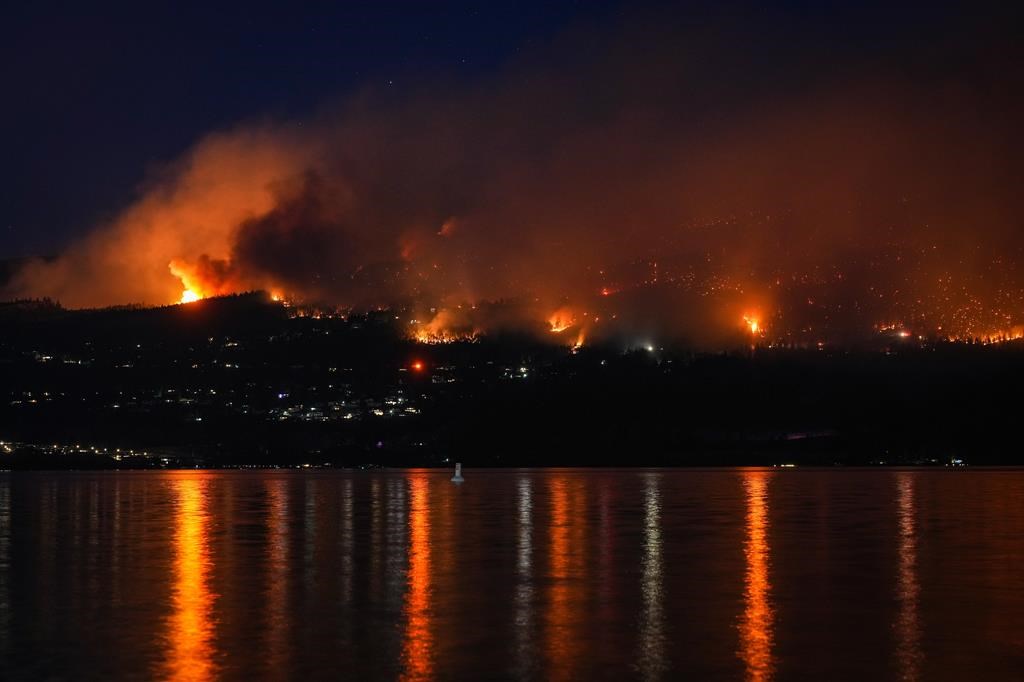Canada to see ‘greater wildfire risks’ due to drought, heat this summer

Posted May 9, 2024 9:14 am.
Last Updated May 9, 2024 9:45 am.
The federal government believes much of Canada will see above-normal temperatures and less precipitation this spring and summer, setting the stage for strong wildfire conditions across the country.
In an update Thursday, the federal Ministry of Public Safety explained the expected weather conditions in the coming months will “lead to greater wildfire risks.”
As of May 9, there were 87 active wildfires burning across Canada, with 38 of those in Alberta alone. Twenty-two are in B.C., with a further nine in Manitoba.
“Approximately 1.47 million hectares have been burned so far,” Minister of Emergency Preparedness Harjit Sajjan said in a news conference. “I urge all Canadians to begin preparations. Climate change is here, and it is real. … It is on our doorsteps, impacting our lives and livelihoods and threatening our communities.”
The ministry explained the ongoing El Niño weather pattern and the climate crisis are fueling the lack of precipitation and warmer temperatures.
“Drought conditions have been observed over the last 12 months across the country along with above normal temperatures,” the feds explained. “ECCC is forecasting continued above-normal temperatures nationwide for the spring and summer period.”
The federal government is particularly concerned about western Canada, with the ministry saying drought is expected in “high-risk” regions in May, including the northern Prairies and interior B.C.

According to Environment and Climate Change Canada data, much of the nation has seen 25 per cent less precipitation than normal over the last 12 months.
While the eastern part of the country saw precipitation in March and April, the weather service says western Canada “remained dry.”
“As we expected this year, the fire season is already taking a toll on Western Canada. Evacuations, for air quality, distressing images can have a significant impact on the physical and mental health of Canadians,” Sajjan continued. “I urge all Canadians to look out for one another. We are Canadians, and this is what we do.”
Minister of Energy and Natural Resources Jonathan Wilkinson explained the government is “aggressively working” to ensure Canadians are prepared for the upcoming wildfire season.
“As folks will know last summer Canadians experienced the most destructive forest fire season in our country’s history,” he explained. “Many lessons were learned on how to proceed and how to be better prepared for the forest fires.”
“Unfortunately, this forecasting continues what has become an alarming but somewhat predictable trend of hot, dry summers that present the perfect conditions for intense fires. Spring wildfire activity is expected to be above normal in areas that have been experiencing prolonged multi-year droughts including Eastern British Columbia, central and northern parts of the Prairies, and the southern parts of the Northwest Territories.”

ECCC says there’s a high probability for “above-normal temperatures through May to July 2024, particularly in high-risk regions. Potential for above normal precipitation over southern Prairies and below normal over northern Alberta in May.”
Due to the lack of rain, the wildfire risk for western Canada increases rapidly between May and June, the ECCC says.
“Areas of intense drought continue to elevate risk: northeast BC, northwest AB, southern NWT,” the feds said Thursday. “Potential for above-normal fire activity: eastern BC; central/northern Prairies; southern NWT; eastern ON; western QC.”

By June, the area of very high or extreme forecast severity is much broader, covering almost all of B.C., Alberta, Saskatchewan, and parts of Manitoba.
Federal Minister of Climate Change and Environment Steven Guilbeault explained that Canada’s climate is warming at twice the rate of the global average, and with the temperatures rising, the nation will see an increased risk of forest fires.
“It’s important to be prepared and to have the tools we need to adapt and be better prepared and react,” he explained. “Climate change is already affecting our climate but also our reality and the way people in Canada live and work.”








